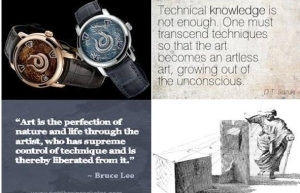“The beginning painter is focused on learning technique with the goal of accuracy. Then comes the realization that composition and design are more important.”
—Robert Bissett
“Learn technique; have full command to the extent of not being conscious of how it is done. When craftsmanship has been developed, you are free to create… technique will give way to expression!”
—Sergei Bongart
“Art is a thing so much of the imagination, of the soul, that it is difficult to descend to the fundamentals of technique and yet make it plain to the student that these are but the ‘means’ and not an end in themselves.”
—John F. Carlson
“The artist can know all the technique in the world, but if he feels nothing, it will mean nothing.”
—Chen Chi
Technique is the ability, the skill, to create or produce something of utilitarian (i.e., advantageous or beneficial) or artistic (i.e., worthy of aesthetic appreciation) value. This is an exclusive “endowment” that separates humanity from the rest of the animal world as we contemplate on how the trajectory of conscious/reflective creativity differs from spontaneity of the instinctual kind. We do not deny the “creativity” of animals but such is reckoned in a context distinct from that of humanity. In the present context—which is the human context—this essay intends to focus exclusively on creative techniques or skills that bring forth aesthetic consequences.
But techniques are not only for aesthetic but also for utilitarian purposes. Utilitarian and aesthetic . . . Is there truly a sharp dividing line? Is there something that is purely utilitarian and thus not aesthetic and vice versa? Or is there actually a point of convergence where something aesthetic is likewise utilitarian and something utilitarian aesthetic? Isn´t the human creative impulse expressed in techniques—or technically expressed—artistic enough so that there is no question at all as to whether its trajectory is utilitarian or aesthetic? This line of thought equates creativity with artistry. In other words, humanity which is basically equipped with creative consciousness in normal circumstances is therefore an artist. This we utterly affirm for the course of human history reveals a rich tapestry of exquisite artistic masterpieces of high cultural achievements in an uninterrupted succession of periods in global civilization.
We are familiar with terms like “the art of proper child-rearing,” “the art of effective resource management,” “the art of successful salesmanship,” even “the art of pleasurable lovemaking” among others. But the use of the term “art” in these instances is in a broader and seemingly all-embracing sense. This more expansive use of the term “art” covers technique itself and hence leads us to the belief that technique is art as well. However, for the present purpose, the term “art” is used in a rather exclusive sense of human expression and appreciation passionately stirred by a distinctively creative urge within a cultural milieu. In this sense, “art” collectively constitutes the known fields and disciplines in human culture called “the arts” such as literature (which includes prose and poetry); visual arts (which includes sculpture, drawing and painting); performing arts (which includes music, dance, opera, theatre and film); and of course, any combination of these artistic disciplines.
Thus, in the process of disambiguating the equivocation of technique and art, it is but proper at this stage to seriously point out that technique is not art without fully disconnecting or alienating one from the other. Though it is true that not all techniques lead to art, one thing that is fundamentally accurate is the fact that a work of art materially emanates from technique. Nevertheless, the fullness of artistic realization does not simply end in such technical production per se. Art is therefore not consummated in the technique that gives it expression. It is not enough that art is simply expressed as a manifestation of the artist´s technical talent. There is an aspect of an artwork that uniquely defines itself without any necessary reference to the adept that has created it and has given it life (of course, in the metaphorical sense), Otherwise, we would continue to hold on to the vague notion that there is a kind of art that is exclusively for art´s sake with unilateral emphasis on the technical performance carried out by the so-called artist.
Strictly, technique is hence not art. Though as we have already pointed out, there is a special sort of technique (skill/ability/talent) that precisely takes its own creative course and leads to art. In this light, technique is a trailblazing equipment—a path-beating instrumentality—that gives “articulation” to art. And technique ends at the point where what it aims to produce has finally been achieved. If it has endeavoured to produce art, art should be seen there and then: an exquisite work of human creativity that is appreciated and valued according to its own impressive and praiseworthy qualities that transcend the prosaic and the trivial. Technique may be valued with a price but the true value of a work of art qua art is not calculated in terms of how it is priced say, in an art gallery or in a bookstore, but in the lasting and substantial cultural impact and transformational influence it moulds/effects/creates in the lives of appreciative individuals. Technique—which in many instances is paid—ends once the fullness of art, in its invaluable and priceless state of positive reception, high esteem and distinguished praiseworthiness, begins. Thus, the absolute consummation of art as such rests on how its very own aesthetic appearance evokes a heightened emotional sensitivity and sensibility to an appreciative enthusiast.
© Ruel F. Pepa, 21 May 2014

